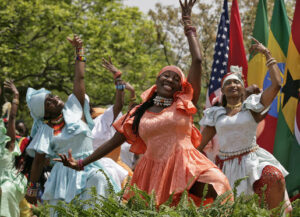Back to: Physical Health Education SS1
Welcome to today’s class!!
We are thrilled to have you in our class!!
In today’s Physical and Health Education class, we will be learning about Nigerian Traditional Dances II
Nigerian Traditional Dances II

Historic and traditional dance goes back hundreds and even thousands of years. Nigeria has the treasure of a variety of folk and tribal dances in regions across the country.
Traditional and cultural dance had been a mainstay in the history of Nigeria. Traditional dances in Nigeria serve different purposes as Nigeria is made up of over 350 ethnic groups and tribes spread across the nooks and crannies of the country with diverse religions, cultures, and traditions.
The eastern region, which consists mostly of the Igbo tribe, has a list of traditional dances performed as a form of emotional expression, social interaction, or exercise, in a spiritual or performance setting, and these dances are sometimes used to express ideas or tell a story.
Let’s take a look at some of these Dances
- Atilogwu (Acrobatic Dance)

This is very similar to performances by cheerleaders in today’s western world. It is known as the ‘Acrobatic Dance” as it requires a lot of quick movements and calisthenics. It is mainly performed by the youth for entertainment at ceremonies or other events.
- Nkwa-Umu-Agbogho Dance

This dance has its origin among the people of Ebonyi State. The Nkwa-Umu-Agbogho dance is also known as the ‘maidens dance‘ because it is specifically meant for ladies who have just become ripe for marriage.
This dance involves vigorous twisting of the chest and waist in a seductive way so as to attract suitors. The ‘maiden dance’ also helps younger girls abstain from premarital sex
- Ekombi Dance

The Ekombi dance is peculiar to the Efik people of Calabar, Cross River State. It is a beautiful and entertaining dance in which maidens are dressed in multi-coloured attires sewn in a mini skirt and blouse form which exposes their tummy. The maidens are also decorated with beads of different colours and sizes. The Ekombi dancers whine gracefully to the rhythmical beats of the Efik drummers in the movement of ocean tides. The Ekombi dance of the Efik people shows the beauty and maturity of a woman.
In summary, Dance is a form of emotional expression, social interaction, or exercise, in a spiritual or performance setting, and these dances are sometimes used to express ideas or tell a story.
Evaluation
Explain the importance of Dance to a culture
Reading Assignment
Cultural dance had been a mainstay in the ………… of Nigeria.
Weekend Assignment
List and explain three types of Dance in your locality.
We hope you enjoyed today’s class. In our next class, we will be talking about Physical Fitness.
Let us know your thoughts and questions in the comment section, and we will attend to them as fast as we can.
